
Commissaris's long-tongued bat is a bat species from South and Central America.
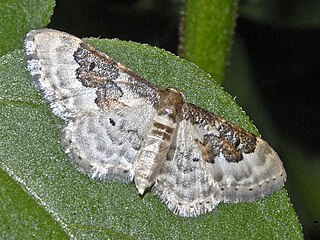
Idaea rusticata, the least carpet, is a moth of the family Geometridae. The species was first described by Michael Denis and Ignaz Schiffermüller in 1775.

Freyer's pug is a moth of the family Geometridae. The species can be found in Europe, east to the Urals, the Russian Far East, Kazakhstan and China. It is also found in North America.

The larch pug is a moth of the family Geometridae. The species can be found in Europe, the Ural Mountains, West and Central Siberia, the Altai Mountains, Transbaikalia, Yakutia, the Far East, Mongolia, Korea, Japan and in North America, from Yukon and Newfoundland to New York and Arizona.

Dioryctria sylvestrella, the new pine knot-horn or maritime pine borer, is a moth of the family Pyralidae. It is found in Europe, parts of Asia and North Africa. The adult is a small mottled brown and white insect with a wingspan of 28 to 35 mm. The moth flies in a single generation from June to October and is a pest of maritime pine and several other species of pine, on which the caterpillars feed.
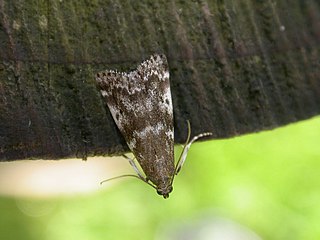
Assara terebrella is a moth of the family Pyralidae. It is found in Europe, Korea, Japan (Hokkaido) and eastern Siberia.
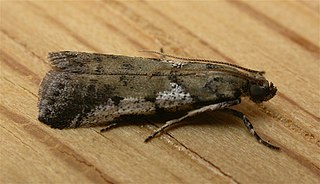
Assara holophragma is a species of moth of the family Pyralidae. It is found in Australia.
Portentomorpha is a genus of moths of the family Crambidae. It contains only one species, Portentomorpha xanthialis, which is found from Texas to Louisiana and Florida, the West Indies and from Mexico to Bolivia.

Prooedema is a monotypic moth genus of the family Crambidae described by George Hampson. Its only species, Prooedema inscisalis, described by Francis Walker in 1865, is found in India, China, Indonesia, the Philippines, Papua New Guinea and Australia, where it has been recorded from the Northern Territory and Queensland.

Assara is a genus of small moths belonging to the snout moth family (Pyralidae). They are part of the tribe Phycitini within the huge snout moth subfamily Phycitinae.
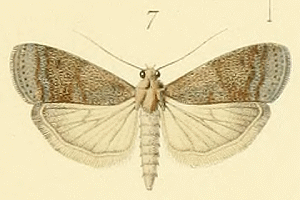
Assara conicolella is a species of snout moth in the genus Assara. It was described by Alexandre Constant in 1884 and is known from France, Corsica and the Iberian Peninsula.
Assara exiguella is a species of snout moth in the genus Assara. It was described by Aristide Caradja in 1926 and is known from China and Japan.
Assara korbi is a species of snout moth in the genus Assara. It was described by Aristide Caradja in 1910 and is known from eastern Asia, including Japan.
Assara pinivora is a species of snout moth in the genus Assara. It was described by Edward Meyrick in 1933 and is known from the Kashmir region of what was then British India.
Assara tuberculosa is a species of snout moth in the genus Assara. It was described by Edward Meyrick in 1933 and is known from Myanmar.
Assara funerella is a species of snout moth in the genus Assara. It was described by Ragonot in 1901. It is found in Taiwan, Japan, China and Korea.
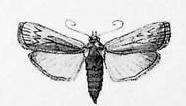
Hypsipyla robusta, the cedar tip moth, is a species of snout moth in the genus Hypsipyla. It was described by Frederic Moore in 1886. It is found from Africa, throughout Asia to Australia. Several undescribed species or subspecies might be involved.
Gymnancyla hornigii is a species of moth in the family Pyralidae. It was described by Julius Lederer in 1852. It is found in most of Europe and Turkey.
Scirpophaga ochroleuca is a moth in the family Crambidae. It was described by Edward Meyrick in 1882. It is found on New Guinea and in Australia, where it has been recorded from Queensland.
Peripatopsis sedgwicki is a species of velvet worm in the Peripatopsidae family. Also known as the Tsitsikamma velvet worm, this species varies from blue-tan green to bright orange and brown violet. The number of legs in this species ranges from 19 pairs to 23 pairs, with a claw present on the genital pair and the last pair reduced more in the male than in the female. Females of this species range in size from 12 mm to 68 mm in length, whereas males range from 10 mm to 46 mm in length. Like other velvet worms in this genus, this species exhibits matrotrophic viviparity, that is, mothers in this genus retain eggs in their uteri and supply nourishment to their embryos, but without any placenta. The type locality is in South Africa. This species has a limited geographic distribution but is especially abundant in the indigenous forest of the Tsitsikamma mountains.









